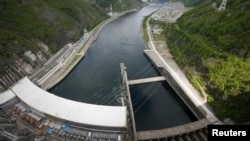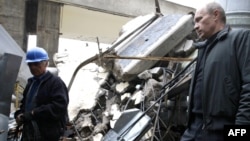On the morning of August 17, 2009, a turbine at the Sayano-Shushenskaya hydroelectric power station in southern Siberia burst apart, sending rocks, shards of metal, and a flood of icy water rushing through the room.
Valentina Gulina, an equipment engineer working in the turbine hall, describes the nightmare that followed.
"We tried to do everything we could," she says. "We put a chair up on a table so that someone could climb up. We did whatever we could so at least someone's life would be saved."
Gulina, who couldn't swim, figured her chances were slim. "I decided that I wasn't going to grab onto anyone or cling to them, because I didn't want to be a burden," she says. "I went underwater and that saved me, because those who were on the surface and holding on were swept away by a wave."
The hall's ceiling collapsed, trapping people beneath the water. In the end, 75 people were killed and hundreds of thousands left without power in what was one of Russia's worst industrial accidents and a grim reminder of the country's infrastructural decay.
Show Trial, Slow Trial
For the fifth year in a row, survivors and relatives of the victims gathered at the Sayano-Shushenksaya plant on August 17 to observe a moment of silence and protest judicial dawdling in the case.
Carrying placards with slogans like "We've been waiting five years for punishment to be doled out," protesters said they were frustrated by what they said were repeated attempts by defense attorneys to delay the trial of several plant managers and safety engineers charged with criminal neglect.
Several protesters said defense lawyers had used vacations and other stalling tactics to slow the pace of the trial, which was opened in 2012.
"We want to use this protest to express our opinion that it's time for these lawyers to start working properly, because every hearing turns into a show," says Natalya Klyukach, whose sister, Yelena, died in the accident.
'No Global Expertise'
In the village of Cheryomushki, home to a majority of the plant's employees, the past five years have felt like an eternity. Many of the residents in the town say they feel like family -- not just because they've weathered a tragedy together, but also because their lives are inextricably entwined with the history of Sayano-Shushenskaya, Russia's largest hydroelectric plant and once considered a jewel in the crown of Soviet industrial planners.
Valentin Stafiyevsky, who went on to head the plant in the 1980s, remembers how workers from all over the Soviet Union settled in tiny Cheryomushki in the 1960s to help build the plant's massive dam spanning the Yenisei River.
"We had to fight against the mountains to build a road between Cheryomushki and [the plant in] Sayanogorsk. It was carved out of the rocks," he says. "It was a period when we literally fought for every possible achievement proving our socialist system was more progressive than the 'decaying' capitalist one."
"It all bears relation to this tragedy five years ago," Stafiyevsky adds. "Because despite the fact that we were able to build such power stations based on our own expertise, we didn't have any global expertise."
Hydropower experts are still debating the cause of the accident, but many -- including Russia's own safety watchdog, Rostekhnadzor, say that the studs in the turbine cover had weakened through basic wear and tear, and had never been replaced. Others said high-frequency vibrations -- too subtle to be registered by the plant's Soviet-era monitoring system -- contributed to the equipment's instability.
An international-standard vibration monitor has since been installed at the Sayano-Shushenskaya plant, which has also seen more than 100 other safety measures put in place, like a shore spillway meant to ensure the security of the dam even during heavy flooding. Nearly all of the turbines are back in operation, and the restoration of the station is due to be completed by the end of this year.
That's little comfort to residents like Alla Bulanovskaya, who lost her son, Yury, in the accident. Prosecutors have just one year left to close the case before a statute of limitations kicks in and nullifies it.
"Five years have passed," Bulanovskaya says angrily, "and there's no sentence."










